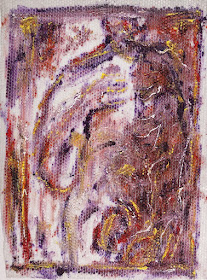"In 1943-1944 Sempoliński studied painting in Konrad Krzyżanowski's underground school in Warsaw. After World War II he studied painting at the Academy of Fine Arts in Warsaw under, among others, Eugeniusz Eibisch (1946-1951, obtained degree in 1956). He has been teaching at his alma mater since 1956. Initially he designed scenery and painted frescoes as well as engaging in traditional easel painting.Between 1953 and 1957 he executed polychrome murals on the facades of reconstructed townhouses of the Old Town and New Town of Warsaw. His paintings should be viewed in the context of two important phenomena in Polish post-war art: the tradition of Polish Colorism (The Capist School), and the ethos of the generation of artists that exhibited at the Arsenal in 1955. While the Capist School saturated his paintings with what can be referred to as a "culture of painting", the experience of the "Arsenal" show added drama to his work and resulted in moral and ethical values informing his canvasses to the same extent as did formal values.In his series dating from the second half of the 1950s (Organy / Organs, Viola da gamba, Kompozycja z trąbką / Composition with Trumpet), the artist focused on music as his subject, drawing from it iconographic themes and simultaneously treating it as a symbolic realm. In the 1960s he began to combine motifs from landscape and architectural studies with color and texture solutions akin to those found in allusive abstract painting (the series Łysica / Lysica Mountain, Wiązy w Machocicach / Elms in Machocice).In the 1970s Sempoliński focused on the relatively abstract issues of color, light, the canvass as painterly space, and textures, for which nature nevertheless remained a legible point of reference (see the series Swiatlo i mrok / Light and Dark, Łąka - zachód słońca / Meadow - Sunset, Studium przestrzeni / Study of Space). In the late 1970s Sempoliński's paintings began to reflect dramatic existential themes, expressed through a change in color scheme (towards dark blues, shades of violet, and cold grays) and even the physical dismantling of the surfaces of his canvasses. His new series Twarz / Face (1971), Ukrzyżowanie / Crucifixion (1975), Moc przeznaczenia Verdiego / The Power of Verdi's Destiny (1977) and Czaszka / Skull (1980s) touched upon issues of religion, culture, and philosophy of life. These works, themselves a sign of important experiences and deep reflection, were a sign of the shift in values that occurred in the 1980s. Jacek Sempolinski's stance in this period gained him the position of both an artistic and intellectual authority, a status he achieved by making numerous public statements, publishing essays, and in other ways. During Martial Law Sempolinski developed links with the independent cultural movement supported by the Catholic Church. He participated in many exhibitions organized by its members, including the memorable projects of Janusz Bogucki and Nina Smolarz (Znak krzyza / Sign of the Cross, Parish on Żytnia Street, Warsaw, 1983; Labirynt - przestrzeń podziemna / Labyrinth - An Underground Space, Church of the Lord's Ascension, Warsaw, 1989), Marek Rostworowski (Niebo nowe i ziemia nowa? / New Sky and New Earth?, Parish on Żytnia Street, Warsaw, 1985), and others."( culture.pl Author: Maryla Sitkowska, Museum of the Academy of Fine Arts in Warsaw, December 2001.)

















No comments:
Post a Comment